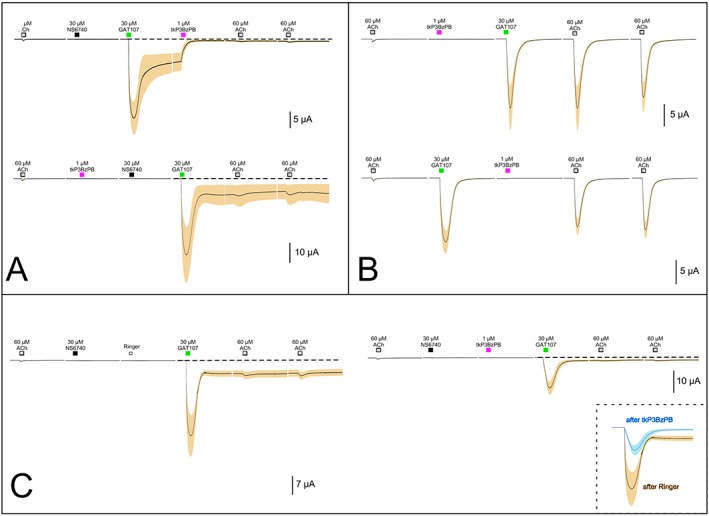Figure 10.

Antagonism of persistent currents in α7 nAChRs with the α7‐selective slowly reversible antagonist tkP3BzPB. (A) Upper trace: sequential application of 30 μM NS6740 and μM GAT107 followed by the application of 1 μM tkP3BzPB (n = 6, average ACh control responses 800 ± 325 nA). Lower trace: 1 μM tkP3BzPB application applied prior to 30 μM NS6740 and μM GAT107 (n = 6, average ACh control response 1.3 ± 0.3 μA). (B) Upper trace: the pre‐application of 1 μM tkP3BzPB prior to the allosteric activation of α7 receptors by 30 μM GAT107 (n = 6, average ACh control responses 750 ± 125 nA). Lower trace: the application of tkP3BzPB during the period of primed potentiation by GAT107 (n = 6, average ACh control responses 700 ± 67 nA). (C) Effects of tkP3BzPB on receptors desensitized by 30 μM NS6740. In the traces on the left, a 12 s application of control Ringer's solution was made following the application of NS6740 (n = 5 average ACh control responses 500 ± 100 nA), and in the traces on the right, a 12 s application of 1 μM tkP3BzPB was made following the NS6740, both prior to the initiation of persistent current by 30 μM GAT107 (n = 8, average ACh responses 600 ± 125 nA). The application of tkP3BzPB significantly inhibited both the GAT107 peak responses and the persistent current measured before the subsequent ACh applications. The inset shows an overlay of the two GAT107 responses.
